Perceptions of Communication in Healthcare: A Literature Review
VerifiedAdded on 2023/03/20
|11
|2987
|47
AI Summary
This literature review explores the perceptions of healthcare professionals and patients about communication in healthcare. It discusses the positive correlation between effective communication and patient safety, satisfaction, and quality of care. The review also highlights the barriers and facilitators of communication in healthcare settings and suggests strategies to improve communication for better patient outcomes.
Contribute Materials
Your contribution can guide someone’s learning journey. Share your
documents today.
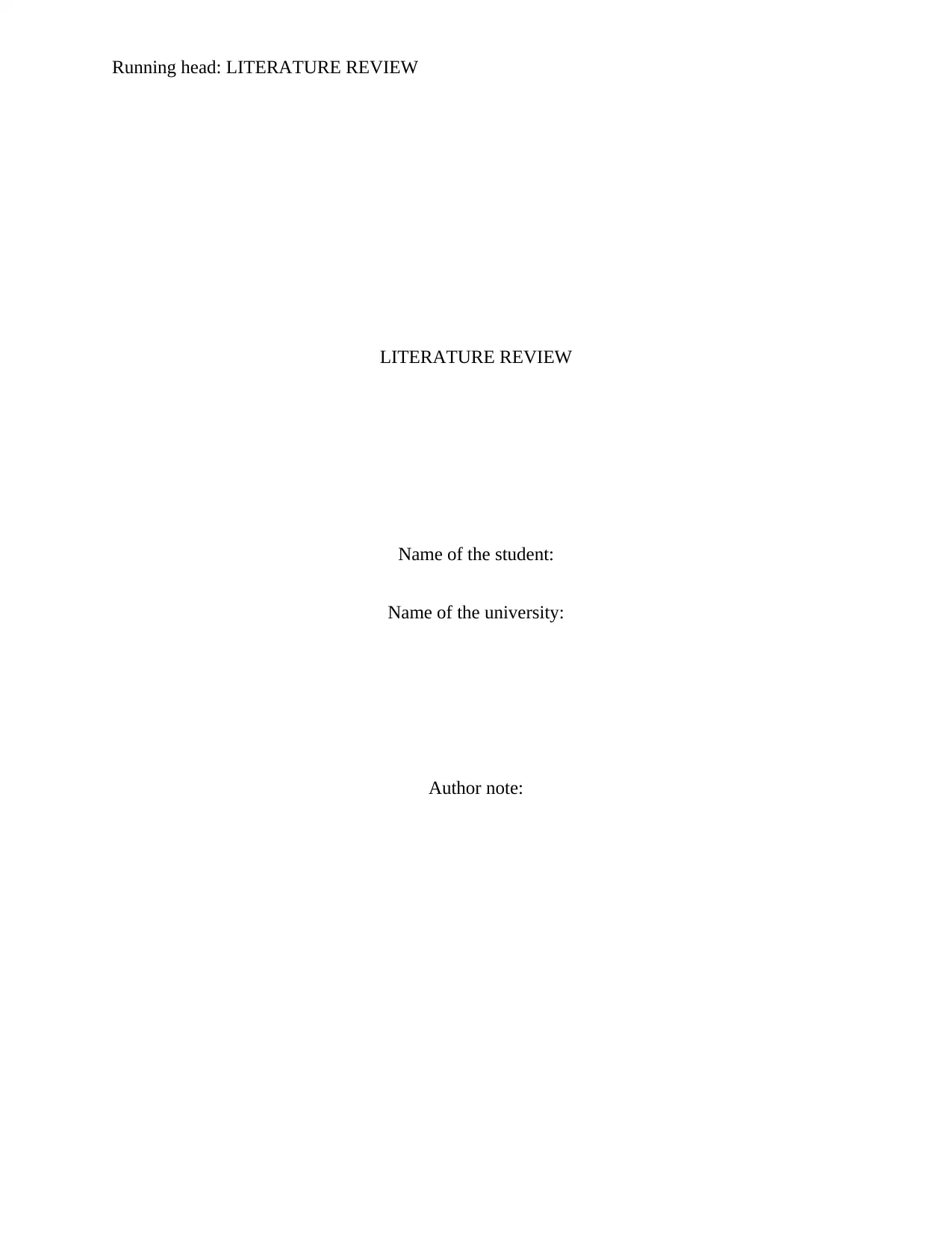
Running head: LITERATURE REVIEW
LITERATURE REVIEW
Name of the student:
Name of the university:
Author note:
LITERATURE REVIEW
Name of the student:
Name of the university:
Author note:
Secure Best Marks with AI Grader
Need help grading? Try our AI Grader for instant feedback on your assignments.
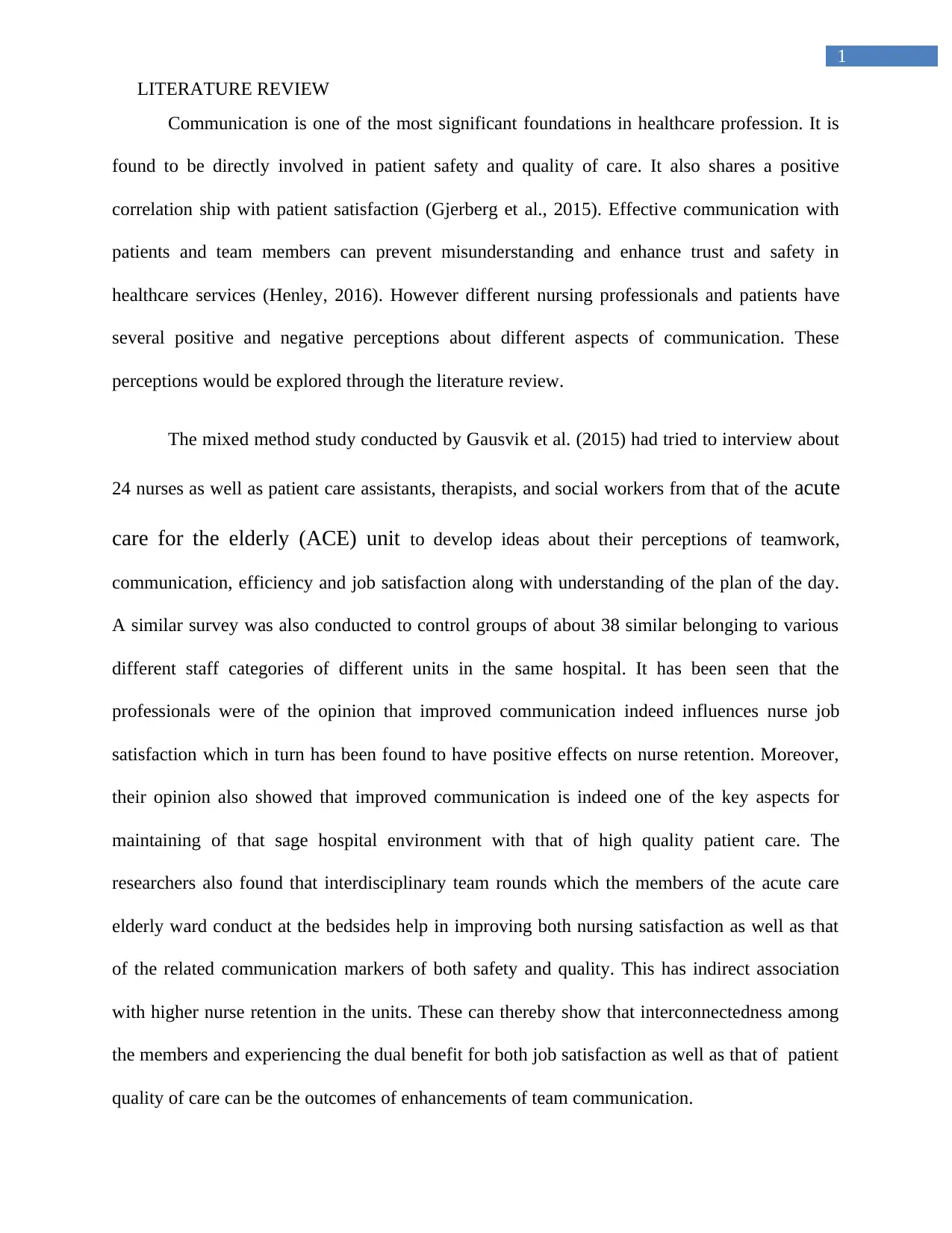
1
LITERATURE REVIEW
Communication is one of the most significant foundations in healthcare profession. It is
found to be directly involved in patient safety and quality of care. It also shares a positive
correlation ship with patient satisfaction (Gjerberg et al., 2015). Effective communication with
patients and team members can prevent misunderstanding and enhance trust and safety in
healthcare services (Henley, 2016). However different nursing professionals and patients have
several positive and negative perceptions about different aspects of communication. These
perceptions would be explored through the literature review.
The mixed method study conducted by Gausvik et al. (2015) had tried to interview about
24 nurses as well as patient care assistants, therapists, and social workers from that of the acute
care for the elderly (ACE) unit to develop ideas about their perceptions of teamwork,
communication, efficiency and job satisfaction along with understanding of the plan of the day.
A similar survey was also conducted to control groups of about 38 similar belonging to various
different staff categories of different units in the same hospital. It has been seen that the
professionals were of the opinion that improved communication indeed influences nurse job
satisfaction which in turn has been found to have positive effects on nurse retention. Moreover,
their opinion also showed that improved communication is indeed one of the key aspects for
maintaining of that sage hospital environment with that of high quality patient care. The
researchers also found that interdisciplinary team rounds which the members of the acute care
elderly ward conduct at the bedsides help in improving both nursing satisfaction as well as that
of the related communication markers of both safety and quality. This has indirect association
with higher nurse retention in the units. These can thereby show that interconnectedness among
the members and experiencing the dual benefit for both job satisfaction as well as that of patient
quality of care can be the outcomes of enhancements of team communication.
LITERATURE REVIEW
Communication is one of the most significant foundations in healthcare profession. It is
found to be directly involved in patient safety and quality of care. It also shares a positive
correlation ship with patient satisfaction (Gjerberg et al., 2015). Effective communication with
patients and team members can prevent misunderstanding and enhance trust and safety in
healthcare services (Henley, 2016). However different nursing professionals and patients have
several positive and negative perceptions about different aspects of communication. These
perceptions would be explored through the literature review.
The mixed method study conducted by Gausvik et al. (2015) had tried to interview about
24 nurses as well as patient care assistants, therapists, and social workers from that of the acute
care for the elderly (ACE) unit to develop ideas about their perceptions of teamwork,
communication, efficiency and job satisfaction along with understanding of the plan of the day.
A similar survey was also conducted to control groups of about 38 similar belonging to various
different staff categories of different units in the same hospital. It has been seen that the
professionals were of the opinion that improved communication indeed influences nurse job
satisfaction which in turn has been found to have positive effects on nurse retention. Moreover,
their opinion also showed that improved communication is indeed one of the key aspects for
maintaining of that sage hospital environment with that of high quality patient care. The
researchers also found that interdisciplinary team rounds which the members of the acute care
elderly ward conduct at the bedsides help in improving both nursing satisfaction as well as that
of the related communication markers of both safety and quality. This has indirect association
with higher nurse retention in the units. These can thereby show that interconnectedness among
the members and experiencing the dual benefit for both job satisfaction as well as that of patient
quality of care can be the outcomes of enhancements of team communication.
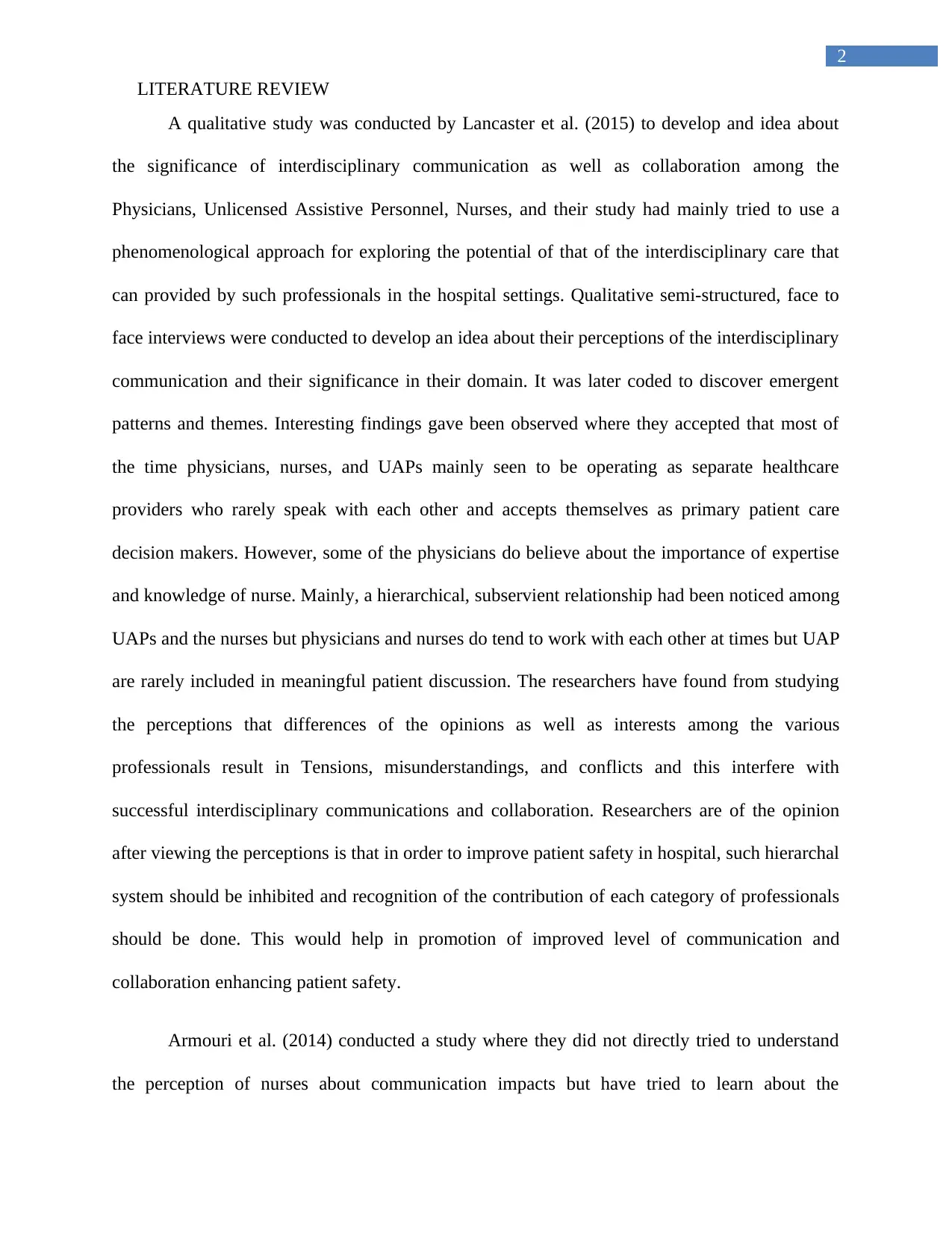
2
LITERATURE REVIEW
A qualitative study was conducted by Lancaster et al. (2015) to develop and idea about
the significance of interdisciplinary communication as well as collaboration among the
Physicians, Unlicensed Assistive Personnel, Nurses, and their study had mainly tried to use a
phenomenological approach for exploring the potential of that of the interdisciplinary care that
can provided by such professionals in the hospital settings. Qualitative semi-structured, face to
face interviews were conducted to develop an idea about their perceptions of the interdisciplinary
communication and their significance in their domain. It was later coded to discover emergent
patterns and themes. Interesting findings gave been observed where they accepted that most of
the time physicians, nurses, and UAPs mainly seen to be operating as separate healthcare
providers who rarely speak with each other and accepts themselves as primary patient care
decision makers. However, some of the physicians do believe about the importance of expertise
and knowledge of nurse. Mainly, a hierarchical, subservient relationship had been noticed among
UAPs and the nurses but physicians and nurses do tend to work with each other at times but UAP
are rarely included in meaningful patient discussion. The researchers have found from studying
the perceptions that differences of the opinions as well as interests among the various
professionals result in Tensions, misunderstandings, and conflicts and this interfere with
successful interdisciplinary communications and collaboration. Researchers are of the opinion
after viewing the perceptions is that in order to improve patient safety in hospital, such hierarchal
system should be inhibited and recognition of the contribution of each category of professionals
should be done. This would help in promotion of improved level of communication and
collaboration enhancing patient safety.
Armouri et al. (2014) conducted a study where they did not directly tried to understand
the perception of nurses about communication impacts but have tried to learn about the
LITERATURE REVIEW
A qualitative study was conducted by Lancaster et al. (2015) to develop and idea about
the significance of interdisciplinary communication as well as collaboration among the
Physicians, Unlicensed Assistive Personnel, Nurses, and their study had mainly tried to use a
phenomenological approach for exploring the potential of that of the interdisciplinary care that
can provided by such professionals in the hospital settings. Qualitative semi-structured, face to
face interviews were conducted to develop an idea about their perceptions of the interdisciplinary
communication and their significance in their domain. It was later coded to discover emergent
patterns and themes. Interesting findings gave been observed where they accepted that most of
the time physicians, nurses, and UAPs mainly seen to be operating as separate healthcare
providers who rarely speak with each other and accepts themselves as primary patient care
decision makers. However, some of the physicians do believe about the importance of expertise
and knowledge of nurse. Mainly, a hierarchical, subservient relationship had been noticed among
UAPs and the nurses but physicians and nurses do tend to work with each other at times but UAP
are rarely included in meaningful patient discussion. The researchers have found from studying
the perceptions that differences of the opinions as well as interests among the various
professionals result in Tensions, misunderstandings, and conflicts and this interfere with
successful interdisciplinary communications and collaboration. Researchers are of the opinion
after viewing the perceptions is that in order to improve patient safety in hospital, such hierarchal
system should be inhibited and recognition of the contribution of each category of professionals
should be done. This would help in promotion of improved level of communication and
collaboration enhancing patient safety.
Armouri et al. (2014) conducted a study where they did not directly tried to understand
the perception of nurses about communication impacts but have tried to learn about the
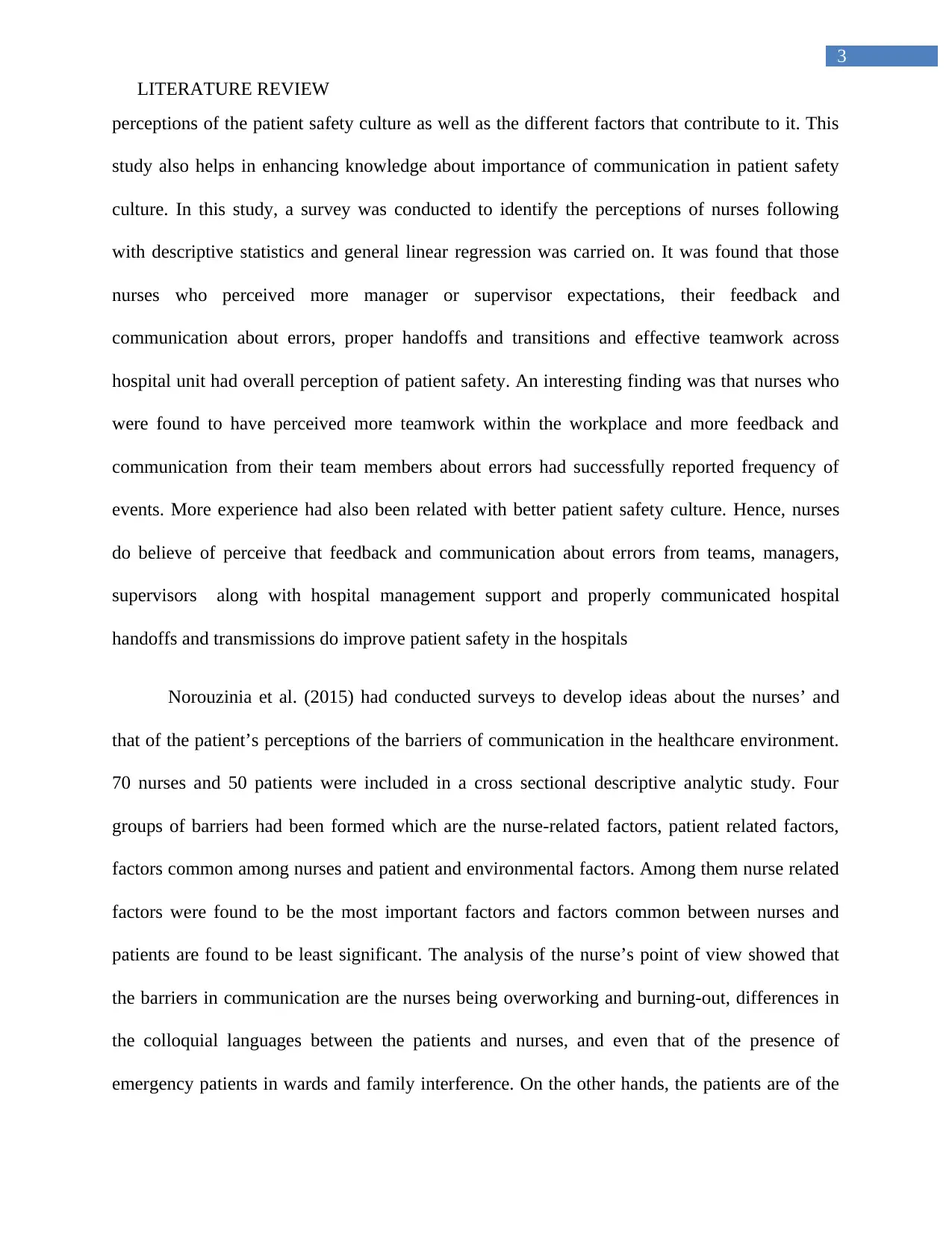
3
LITERATURE REVIEW
perceptions of the patient safety culture as well as the different factors that contribute to it. This
study also helps in enhancing knowledge about importance of communication in patient safety
culture. In this study, a survey was conducted to identify the perceptions of nurses following
with descriptive statistics and general linear regression was carried on. It was found that those
nurses who perceived more manager or supervisor expectations, their feedback and
communication about errors, proper handoffs and transitions and effective teamwork across
hospital unit had overall perception of patient safety. An interesting finding was that nurses who
were found to have perceived more teamwork within the workplace and more feedback and
communication from their team members about errors had successfully reported frequency of
events. More experience had also been related with better patient safety culture. Hence, nurses
do believe of perceive that feedback and communication about errors from teams, managers,
supervisors along with hospital management support and properly communicated hospital
handoffs and transmissions do improve patient safety in the hospitals
Norouzinia et al. (2015) had conducted surveys to develop ideas about the nurses’ and
that of the patient’s perceptions of the barriers of communication in the healthcare environment.
70 nurses and 50 patients were included in a cross sectional descriptive analytic study. Four
groups of barriers had been formed which are the nurse-related factors, patient related factors,
factors common among nurses and patient and environmental factors. Among them nurse related
factors were found to be the most important factors and factors common between nurses and
patients are found to be least significant. The analysis of the nurse’s point of view showed that
the barriers in communication are the nurses being overworking and burning-out, differences in
the colloquial languages between the patients and nurses, and even that of the presence of
emergency patients in wards and family interference. On the other hands, the patients are of the
LITERATURE REVIEW
perceptions of the patient safety culture as well as the different factors that contribute to it. This
study also helps in enhancing knowledge about importance of communication in patient safety
culture. In this study, a survey was conducted to identify the perceptions of nurses following
with descriptive statistics and general linear regression was carried on. It was found that those
nurses who perceived more manager or supervisor expectations, their feedback and
communication about errors, proper handoffs and transitions and effective teamwork across
hospital unit had overall perception of patient safety. An interesting finding was that nurses who
were found to have perceived more teamwork within the workplace and more feedback and
communication from their team members about errors had successfully reported frequency of
events. More experience had also been related with better patient safety culture. Hence, nurses
do believe of perceive that feedback and communication about errors from teams, managers,
supervisors along with hospital management support and properly communicated hospital
handoffs and transmissions do improve patient safety in the hospitals
Norouzinia et al. (2015) had conducted surveys to develop ideas about the nurses’ and
that of the patient’s perceptions of the barriers of communication in the healthcare environment.
70 nurses and 50 patients were included in a cross sectional descriptive analytic study. Four
groups of barriers had been formed which are the nurse-related factors, patient related factors,
factors common among nurses and patient and environmental factors. Among them nurse related
factors were found to be the most important factors and factors common between nurses and
patients are found to be least significant. The analysis of the nurse’s point of view showed that
the barriers in communication are the nurses being overworking and burning-out, differences in
the colloquial languages between the patients and nurses, and even that of the presence of
emergency patients in wards and family interference. On the other hands, the patients are of the
Secure Best Marks with AI Grader
Need help grading? Try our AI Grader for instant feedback on your assignments.
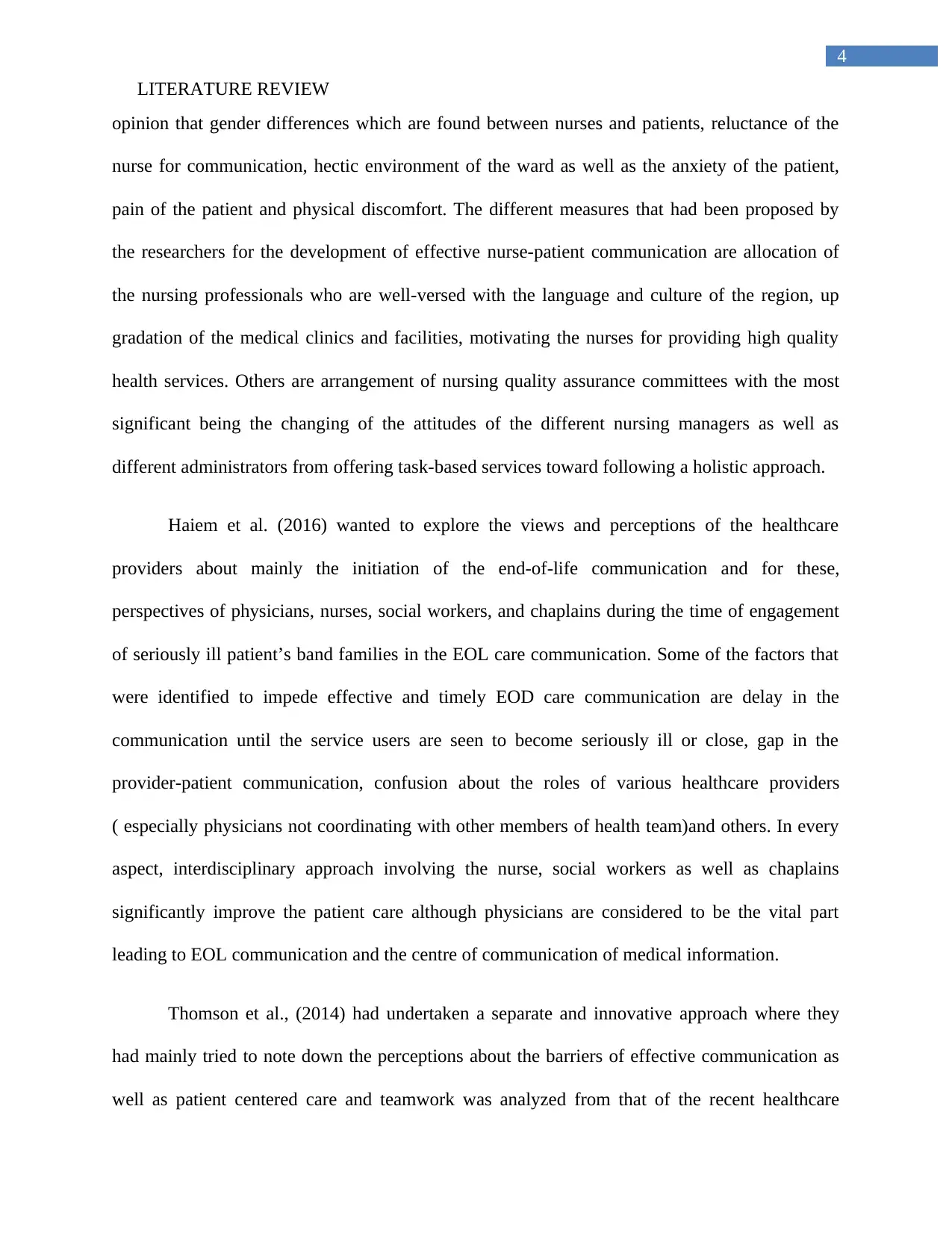
4
LITERATURE REVIEW
opinion that gender differences which are found between nurses and patients, reluctance of the
nurse for communication, hectic environment of the ward as well as the anxiety of the patient,
pain of the patient and physical discomfort. The different measures that had been proposed by
the researchers for the development of effective nurse-patient communication are allocation of
the nursing professionals who are well-versed with the language and culture of the region, up
gradation of the medical clinics and facilities, motivating the nurses for providing high quality
health services. Others are arrangement of nursing quality assurance committees with the most
significant being the changing of the attitudes of the different nursing managers as well as
different administrators from offering task-based services toward following a holistic approach.
Haiem et al. (2016) wanted to explore the views and perceptions of the healthcare
providers about mainly the initiation of the end-of-life communication and for these,
perspectives of physicians, nurses, social workers, and chaplains during the time of engagement
of seriously ill patient’s band families in the EOL care communication. Some of the factors that
were identified to impede effective and timely EOD care communication are delay in the
communication until the service users are seen to become seriously ill or close, gap in the
provider-patient communication, confusion about the roles of various healthcare providers
( especially physicians not coordinating with other members of health team)and others. In every
aspect, interdisciplinary approach involving the nurse, social workers as well as chaplains
significantly improve the patient care although physicians are considered to be the vital part
leading to EOL communication and the centre of communication of medical information.
Thomson et al., (2014) had undertaken a separate and innovative approach where they
had mainly tried to note down the perceptions about the barriers of effective communication as
well as patient centered care and teamwork was analyzed from that of the recent healthcare
LITERATURE REVIEW
opinion that gender differences which are found between nurses and patients, reluctance of the
nurse for communication, hectic environment of the ward as well as the anxiety of the patient,
pain of the patient and physical discomfort. The different measures that had been proposed by
the researchers for the development of effective nurse-patient communication are allocation of
the nursing professionals who are well-versed with the language and culture of the region, up
gradation of the medical clinics and facilities, motivating the nurses for providing high quality
health services. Others are arrangement of nursing quality assurance committees with the most
significant being the changing of the attitudes of the different nursing managers as well as
different administrators from offering task-based services toward following a holistic approach.
Haiem et al. (2016) wanted to explore the views and perceptions of the healthcare
providers about mainly the initiation of the end-of-life communication and for these,
perspectives of physicians, nurses, social workers, and chaplains during the time of engagement
of seriously ill patient’s band families in the EOL care communication. Some of the factors that
were identified to impede effective and timely EOD care communication are delay in the
communication until the service users are seen to become seriously ill or close, gap in the
provider-patient communication, confusion about the roles of various healthcare providers
( especially physicians not coordinating with other members of health team)and others. In every
aspect, interdisciplinary approach involving the nurse, social workers as well as chaplains
significantly improve the patient care although physicians are considered to be the vital part
leading to EOL communication and the centre of communication of medical information.
Thomson et al., (2014) had undertaken a separate and innovative approach where they
had mainly tried to note down the perceptions about the barriers of effective communication as
well as patient centered care and teamwork was analyzed from that of the recent healthcare

5
LITERATURE REVIEW
graduates. 12 semi-structured focus group discussions were seen to have been conducted in
clinical workplaces across three states of Australia taking a total of around 68 nursing, pharmacy
and medicine graduates. It was astonishing for the researchers to have found out that a consistent
pattern of profession focused rather than patient or team focused goals were found in the reports.
Other reports of hierarchical communication along with negative stereotyping along with
competition for time with that of the patient are the significant barriers reported by the new
graduate nurses. it had been found that they indeed acknowledged the significance of teamwork,
communication as well as patient-centered care and also told that a better understanding of the
different functions and roles of the different types of health professionals would be assisting
them in working for better well-being of the patient. Differential goals as well as gaining
workplace identities have also been seen to motivate the new nurses to develop professional
behaviors improving inter-professional collaboration for initiating effective communication
among inter-professional teams.
The authors Tobiano et al. (2017) had found out interesting aspects that guide effective
bedside handovers as well as their implications on the clinical practices. The author had
conducted a survey of about 200 nurses on the medical wards by recruiting them from two
Australian hospitals. Here open-ended questionnaires were prepared by the authors to understand
the perceptions of nurses as the barriers to that of the effective bedside handover. Among the
three important concerning barriers noted by nurses like patients and third parties listening to
sensitive barriers as well as individual nurse and patient views and capabilities hindering in
effective bedside handover, communication do play important barrier as well. Many of the
nurses were of the perceptions that often patients, family members and other nurses disrupt
communication flow that result in interruption of handover and also increase the duration of the
LITERATURE REVIEW
graduates. 12 semi-structured focus group discussions were seen to have been conducted in
clinical workplaces across three states of Australia taking a total of around 68 nursing, pharmacy
and medicine graduates. It was astonishing for the researchers to have found out that a consistent
pattern of profession focused rather than patient or team focused goals were found in the reports.
Other reports of hierarchical communication along with negative stereotyping along with
competition for time with that of the patient are the significant barriers reported by the new
graduate nurses. it had been found that they indeed acknowledged the significance of teamwork,
communication as well as patient-centered care and also told that a better understanding of the
different functions and roles of the different types of health professionals would be assisting
them in working for better well-being of the patient. Differential goals as well as gaining
workplace identities have also been seen to motivate the new nurses to develop professional
behaviors improving inter-professional collaboration for initiating effective communication
among inter-professional teams.
The authors Tobiano et al. (2017) had found out interesting aspects that guide effective
bedside handovers as well as their implications on the clinical practices. The author had
conducted a survey of about 200 nurses on the medical wards by recruiting them from two
Australian hospitals. Here open-ended questionnaires were prepared by the authors to understand
the perceptions of nurses as the barriers to that of the effective bedside handover. Among the
three important concerning barriers noted by nurses like patients and third parties listening to
sensitive barriers as well as individual nurse and patient views and capabilities hindering in
effective bedside handover, communication do play important barrier as well. Many of the
nurses were of the perceptions that often patients, family members and other nurses disrupt
communication flow that result in interruption of handover and also increase the duration of the
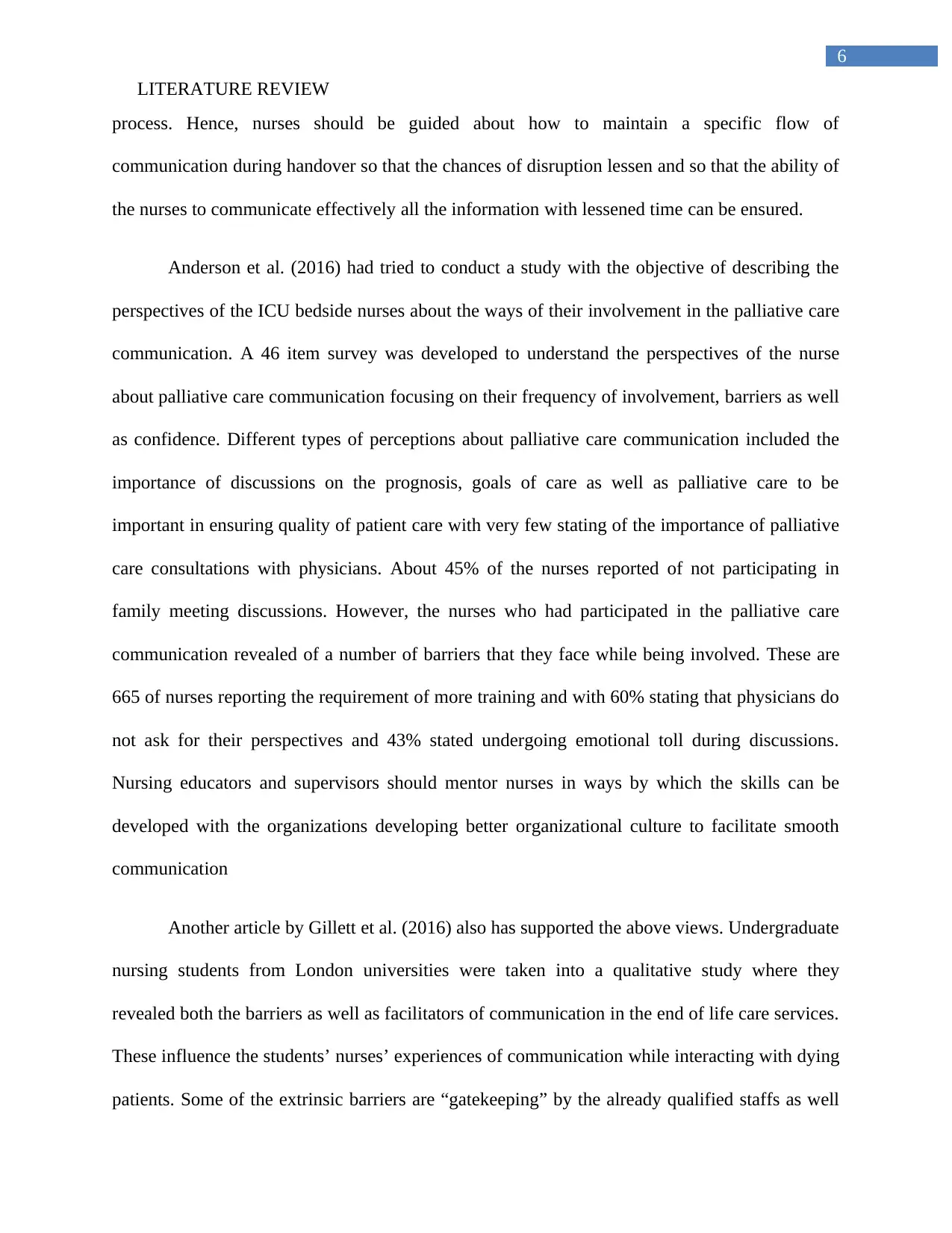
6
LITERATURE REVIEW
process. Hence, nurses should be guided about how to maintain a specific flow of
communication during handover so that the chances of disruption lessen and so that the ability of
the nurses to communicate effectively all the information with lessened time can be ensured.
Anderson et al. (2016) had tried to conduct a study with the objective of describing the
perspectives of the ICU bedside nurses about the ways of their involvement in the palliative care
communication. A 46 item survey was developed to understand the perspectives of the nurse
about palliative care communication focusing on their frequency of involvement, barriers as well
as confidence. Different types of perceptions about palliative care communication included the
importance of discussions on the prognosis, goals of care as well as palliative care to be
important in ensuring quality of patient care with very few stating of the importance of palliative
care consultations with physicians. About 45% of the nurses reported of not participating in
family meeting discussions. However, the nurses who had participated in the palliative care
communication revealed of a number of barriers that they face while being involved. These are
665 of nurses reporting the requirement of more training and with 60% stating that physicians do
not ask for their perspectives and 43% stated undergoing emotional toll during discussions.
Nursing educators and supervisors should mentor nurses in ways by which the skills can be
developed with the organizations developing better organizational culture to facilitate smooth
communication
Another article by Gillett et al. (2016) also has supported the above views. Undergraduate
nursing students from London universities were taken into a qualitative study where they
revealed both the barriers as well as facilitators of communication in the end of life care services.
These influence the students’ nurses’ experiences of communication while interacting with dying
patients. Some of the extrinsic barriers are “gatekeeping” by the already qualified staffs as well
LITERATURE REVIEW
process. Hence, nurses should be guided about how to maintain a specific flow of
communication during handover so that the chances of disruption lessen and so that the ability of
the nurses to communicate effectively all the information with lessened time can be ensured.
Anderson et al. (2016) had tried to conduct a study with the objective of describing the
perspectives of the ICU bedside nurses about the ways of their involvement in the palliative care
communication. A 46 item survey was developed to understand the perspectives of the nurse
about palliative care communication focusing on their frequency of involvement, barriers as well
as confidence. Different types of perceptions about palliative care communication included the
importance of discussions on the prognosis, goals of care as well as palliative care to be
important in ensuring quality of patient care with very few stating of the importance of palliative
care consultations with physicians. About 45% of the nurses reported of not participating in
family meeting discussions. However, the nurses who had participated in the palliative care
communication revealed of a number of barriers that they face while being involved. These are
665 of nurses reporting the requirement of more training and with 60% stating that physicians do
not ask for their perspectives and 43% stated undergoing emotional toll during discussions.
Nursing educators and supervisors should mentor nurses in ways by which the skills can be
developed with the organizations developing better organizational culture to facilitate smooth
communication
Another article by Gillett et al. (2016) also has supported the above views. Undergraduate
nursing students from London universities were taken into a qualitative study where they
revealed both the barriers as well as facilitators of communication in the end of life care services.
These influence the students’ nurses’ experiences of communication while interacting with dying
patients. Some of the extrinsic barriers are “gatekeeping” by the already qualified staffs as well
Paraphrase This Document
Need a fresh take? Get an instant paraphrase of this document with our AI Paraphraser
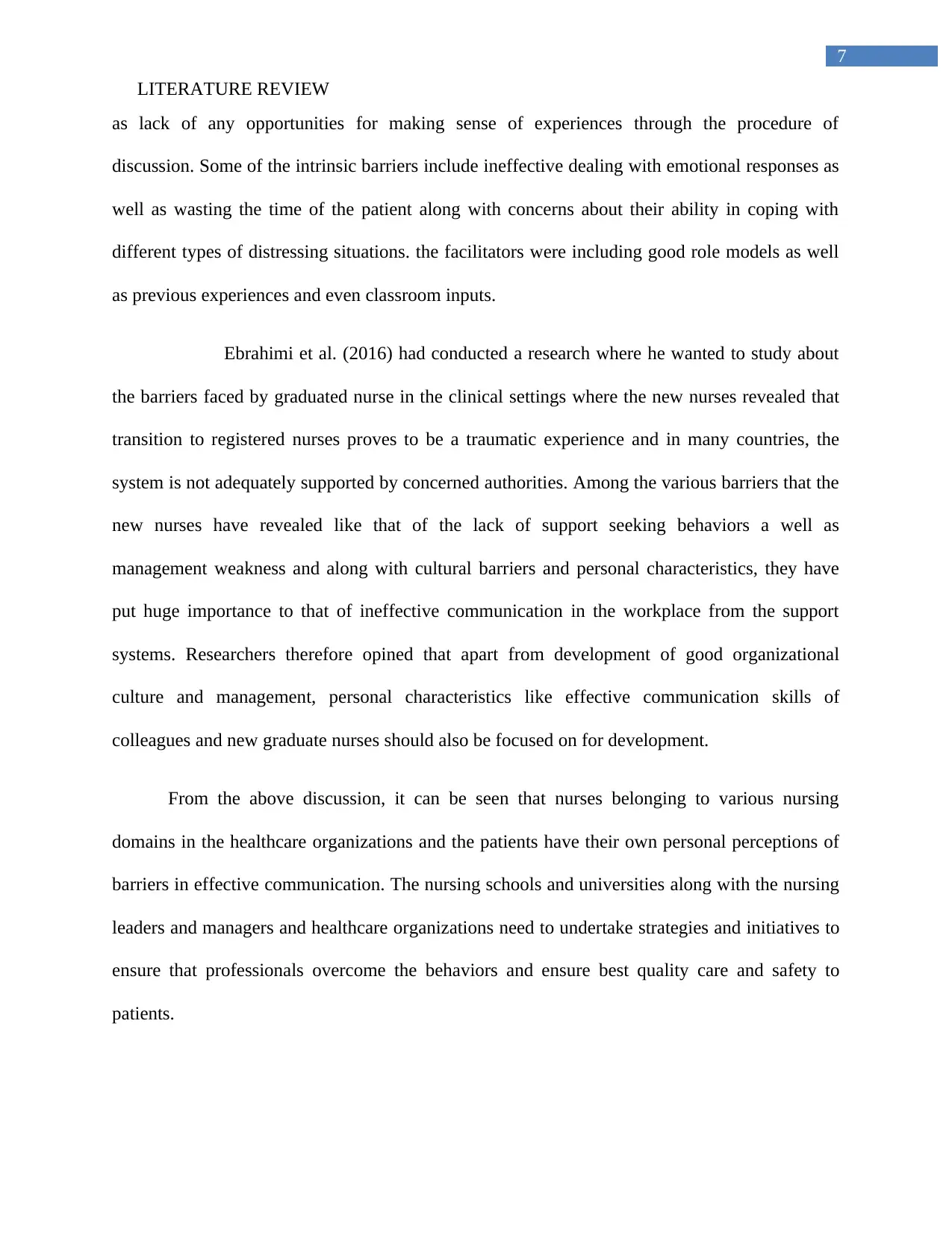
7
LITERATURE REVIEW
as lack of any opportunities for making sense of experiences through the procedure of
discussion. Some of the intrinsic barriers include ineffective dealing with emotional responses as
well as wasting the time of the patient along with concerns about their ability in coping with
different types of distressing situations. the facilitators were including good role models as well
as previous experiences and even classroom inputs.
Ebrahimi et al. (2016) had conducted a research where he wanted to study about
the barriers faced by graduated nurse in the clinical settings where the new nurses revealed that
transition to registered nurses proves to be a traumatic experience and in many countries, the
system is not adequately supported by concerned authorities. Among the various barriers that the
new nurses have revealed like that of the lack of support seeking behaviors a well as
management weakness and along with cultural barriers and personal characteristics, they have
put huge importance to that of ineffective communication in the workplace from the support
systems. Researchers therefore opined that apart from development of good organizational
culture and management, personal characteristics like effective communication skills of
colleagues and new graduate nurses should also be focused on for development.
From the above discussion, it can be seen that nurses belonging to various nursing
domains in the healthcare organizations and the patients have their own personal perceptions of
barriers in effective communication. The nursing schools and universities along with the nursing
leaders and managers and healthcare organizations need to undertake strategies and initiatives to
ensure that professionals overcome the behaviors and ensure best quality care and safety to
patients.
LITERATURE REVIEW
as lack of any opportunities for making sense of experiences through the procedure of
discussion. Some of the intrinsic barriers include ineffective dealing with emotional responses as
well as wasting the time of the patient along with concerns about their ability in coping with
different types of distressing situations. the facilitators were including good role models as well
as previous experiences and even classroom inputs.
Ebrahimi et al. (2016) had conducted a research where he wanted to study about
the barriers faced by graduated nurse in the clinical settings where the new nurses revealed that
transition to registered nurses proves to be a traumatic experience and in many countries, the
system is not adequately supported by concerned authorities. Among the various barriers that the
new nurses have revealed like that of the lack of support seeking behaviors a well as
management weakness and along with cultural barriers and personal characteristics, they have
put huge importance to that of ineffective communication in the workplace from the support
systems. Researchers therefore opined that apart from development of good organizational
culture and management, personal characteristics like effective communication skills of
colleagues and new graduate nurses should also be focused on for development.
From the above discussion, it can be seen that nurses belonging to various nursing
domains in the healthcare organizations and the patients have their own personal perceptions of
barriers in effective communication. The nursing schools and universities along with the nursing
leaders and managers and healthcare organizations need to undertake strategies and initiatives to
ensure that professionals overcome the behaviors and ensure best quality care and safety to
patients.
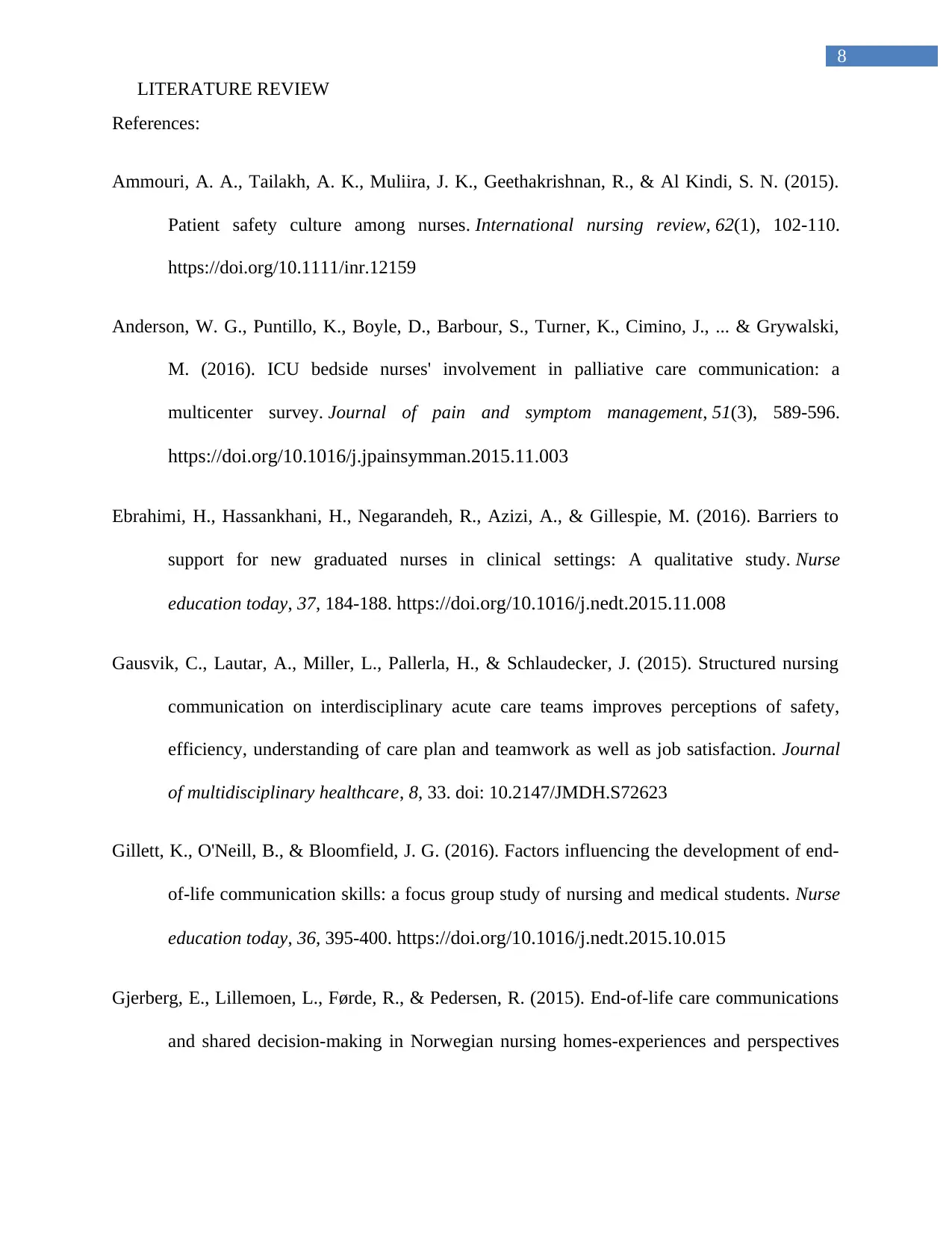
8
LITERATURE REVIEW
References:
Ammouri, A. A., Tailakh, A. K., Muliira, J. K., Geethakrishnan, R., & Al Kindi, S. N. (2015).
Patient safety culture among nurses. International nursing review, 62(1), 102-110.
https://doi.org/10.1111/inr.12159
Anderson, W. G., Puntillo, K., Boyle, D., Barbour, S., Turner, K., Cimino, J., ... & Grywalski,
M. (2016). ICU bedside nurses' involvement in palliative care communication: a
multicenter survey. Journal of pain and symptom management, 51(3), 589-596.
https://doi.org/10.1016/j.jpainsymman.2015.11.003
Ebrahimi, H., Hassankhani, H., Negarandeh, R., Azizi, A., & Gillespie, M. (2016). Barriers to
support for new graduated nurses in clinical settings: A qualitative study. Nurse
education today, 37, 184-188. https://doi.org/10.1016/j.nedt.2015.11.008
Gausvik, C., Lautar, A., Miller, L., Pallerla, H., & Schlaudecker, J. (2015). Structured nursing
communication on interdisciplinary acute care teams improves perceptions of safety,
efficiency, understanding of care plan and teamwork as well as job satisfaction. Journal
of multidisciplinary healthcare, 8, 33. doi: 10.2147/JMDH.S72623
Gillett, K., O'Neill, B., & Bloomfield, J. G. (2016). Factors influencing the development of end-
of-life communication skills: a focus group study of nursing and medical students. Nurse
education today, 36, 395-400. https://doi.org/10.1016/j.nedt.2015.10.015
Gjerberg, E., Lillemoen, L., Førde, R., & Pedersen, R. (2015). End-of-life care communications
and shared decision-making in Norwegian nursing homes-experiences and perspectives
LITERATURE REVIEW
References:
Ammouri, A. A., Tailakh, A. K., Muliira, J. K., Geethakrishnan, R., & Al Kindi, S. N. (2015).
Patient safety culture among nurses. International nursing review, 62(1), 102-110.
https://doi.org/10.1111/inr.12159
Anderson, W. G., Puntillo, K., Boyle, D., Barbour, S., Turner, K., Cimino, J., ... & Grywalski,
M. (2016). ICU bedside nurses' involvement in palliative care communication: a
multicenter survey. Journal of pain and symptom management, 51(3), 589-596.
https://doi.org/10.1016/j.jpainsymman.2015.11.003
Ebrahimi, H., Hassankhani, H., Negarandeh, R., Azizi, A., & Gillespie, M. (2016). Barriers to
support for new graduated nurses in clinical settings: A qualitative study. Nurse
education today, 37, 184-188. https://doi.org/10.1016/j.nedt.2015.11.008
Gausvik, C., Lautar, A., Miller, L., Pallerla, H., & Schlaudecker, J. (2015). Structured nursing
communication on interdisciplinary acute care teams improves perceptions of safety,
efficiency, understanding of care plan and teamwork as well as job satisfaction. Journal
of multidisciplinary healthcare, 8, 33. doi: 10.2147/JMDH.S72623
Gillett, K., O'Neill, B., & Bloomfield, J. G. (2016). Factors influencing the development of end-
of-life communication skills: a focus group study of nursing and medical students. Nurse
education today, 36, 395-400. https://doi.org/10.1016/j.nedt.2015.10.015
Gjerberg, E., Lillemoen, L., Førde, R., & Pedersen, R. (2015). End-of-life care communications
and shared decision-making in Norwegian nursing homes-experiences and perspectives
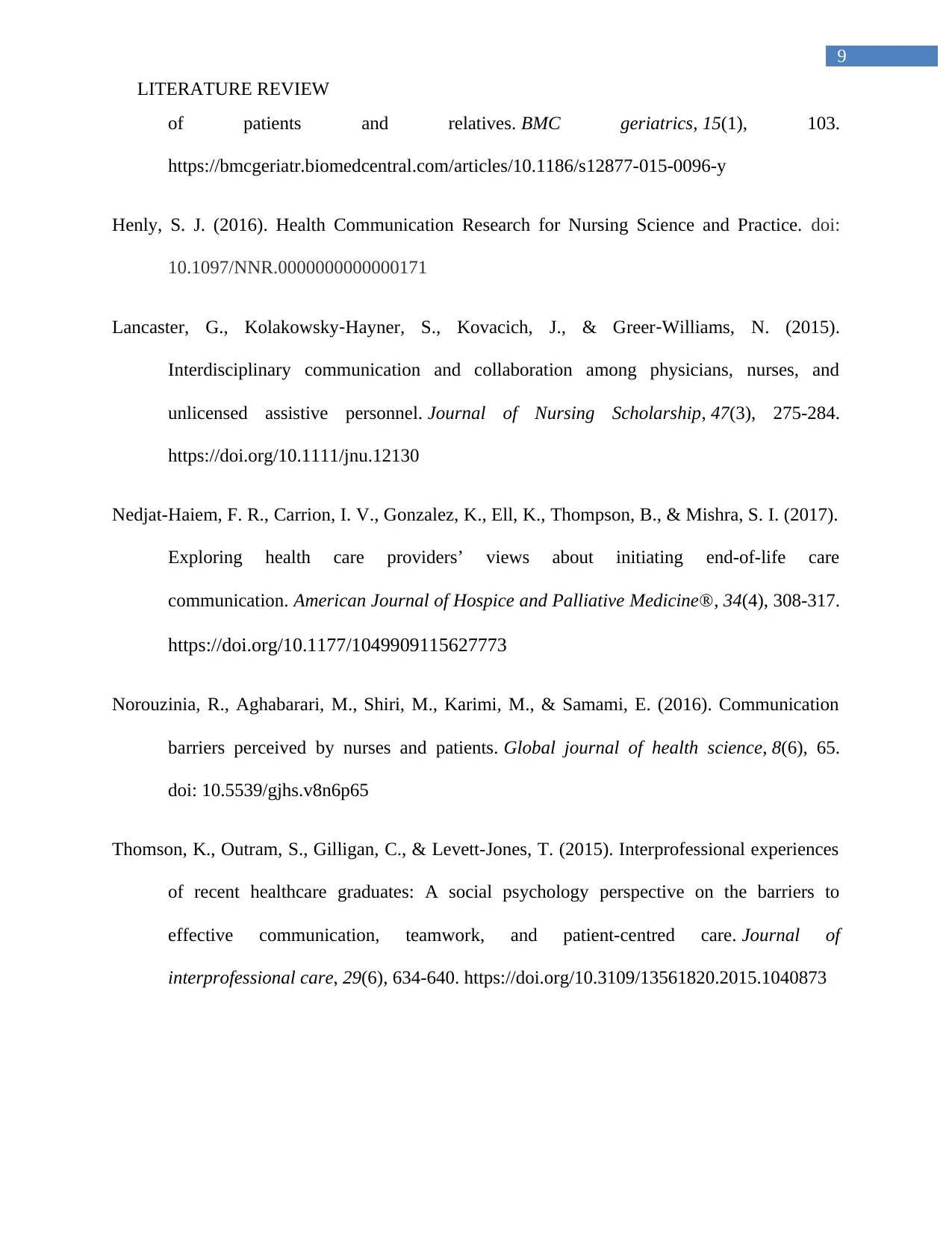
9
LITERATURE REVIEW
of patients and relatives. BMC geriatrics, 15(1), 103.
https://bmcgeriatr.biomedcentral.com/articles/10.1186/s12877-015-0096-y
Henly, S. J. (2016). Health Communication Research for Nursing Science and Practice. doi:
10.1097/NNR.0000000000000171
Lancaster, G., Kolakowsky‐Hayner, S., Kovacich, J., & Greer‐Williams, N. (2015).
Interdisciplinary communication and collaboration among physicians, nurses, and
unlicensed assistive personnel. Journal of Nursing Scholarship, 47(3), 275-284.
https://doi.org/10.1111/jnu.12130
Nedjat-Haiem, F. R., Carrion, I. V., Gonzalez, K., Ell, K., Thompson, B., & Mishra, S. I. (2017).
Exploring health care providers’ views about initiating end-of-life care
communication. American Journal of Hospice and Palliative Medicine®, 34(4), 308-317.
https://doi.org/10.1177/1049909115627773
Norouzinia, R., Aghabarari, M., Shiri, M., Karimi, M., & Samami, E. (2016). Communication
barriers perceived by nurses and patients. Global journal of health science, 8(6), 65.
doi: 10.5539/gjhs.v8n6p65
Thomson, K., Outram, S., Gilligan, C., & Levett-Jones, T. (2015). Interprofessional experiences
of recent healthcare graduates: A social psychology perspective on the barriers to
effective communication, teamwork, and patient-centred care. Journal of
interprofessional care, 29(6), 634-640. https://doi.org/10.3109/13561820.2015.1040873
LITERATURE REVIEW
of patients and relatives. BMC geriatrics, 15(1), 103.
https://bmcgeriatr.biomedcentral.com/articles/10.1186/s12877-015-0096-y
Henly, S. J. (2016). Health Communication Research for Nursing Science and Practice. doi:
10.1097/NNR.0000000000000171
Lancaster, G., Kolakowsky‐Hayner, S., Kovacich, J., & Greer‐Williams, N. (2015).
Interdisciplinary communication and collaboration among physicians, nurses, and
unlicensed assistive personnel. Journal of Nursing Scholarship, 47(3), 275-284.
https://doi.org/10.1111/jnu.12130
Nedjat-Haiem, F. R., Carrion, I. V., Gonzalez, K., Ell, K., Thompson, B., & Mishra, S. I. (2017).
Exploring health care providers’ views about initiating end-of-life care
communication. American Journal of Hospice and Palliative Medicine®, 34(4), 308-317.
https://doi.org/10.1177/1049909115627773
Norouzinia, R., Aghabarari, M., Shiri, M., Karimi, M., & Samami, E. (2016). Communication
barriers perceived by nurses and patients. Global journal of health science, 8(6), 65.
doi: 10.5539/gjhs.v8n6p65
Thomson, K., Outram, S., Gilligan, C., & Levett-Jones, T. (2015). Interprofessional experiences
of recent healthcare graduates: A social psychology perspective on the barriers to
effective communication, teamwork, and patient-centred care. Journal of
interprofessional care, 29(6), 634-640. https://doi.org/10.3109/13561820.2015.1040873
Secure Best Marks with AI Grader
Need help grading? Try our AI Grader for instant feedback on your assignments.
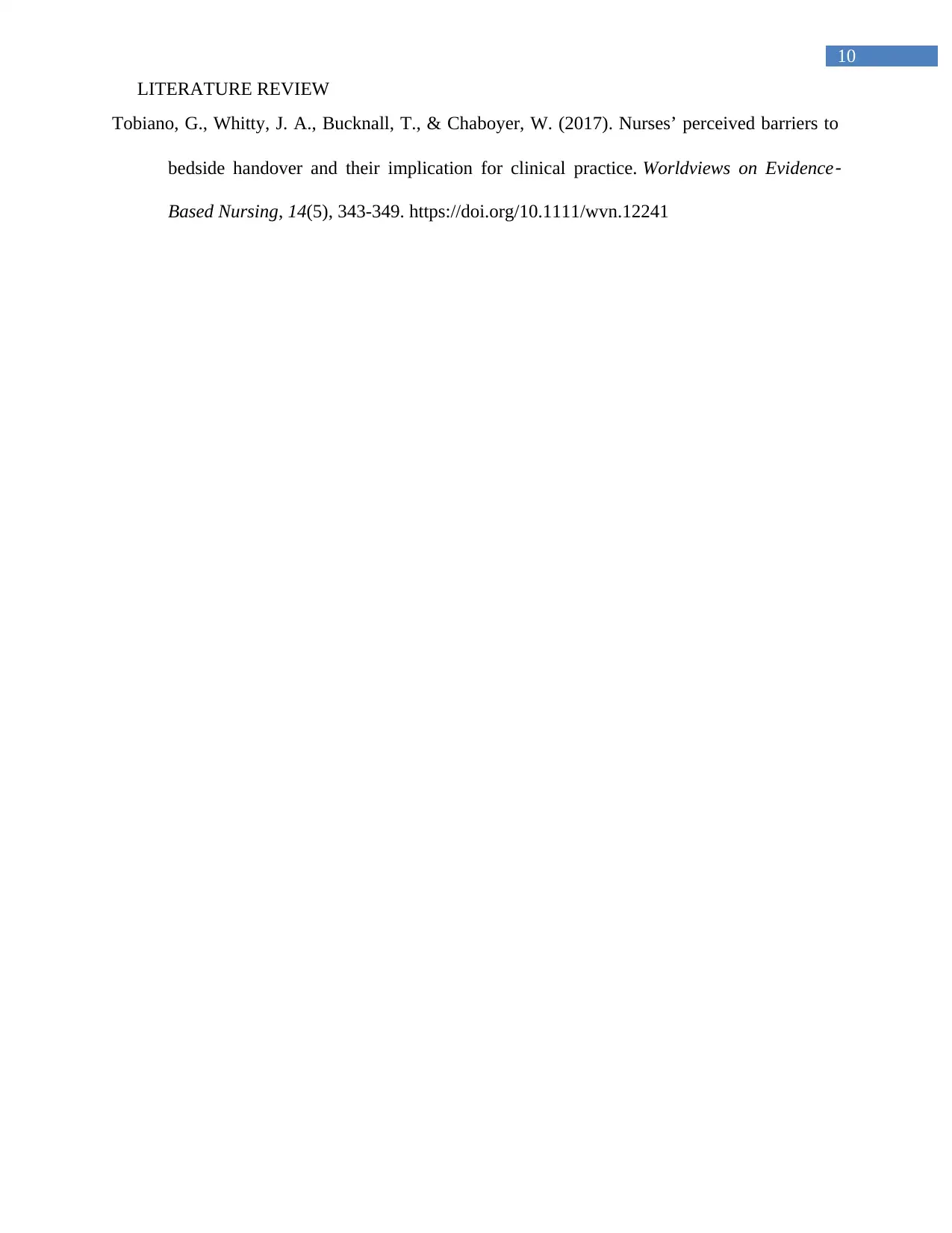
10
LITERATURE REVIEW
Tobiano, G., Whitty, J. A., Bucknall, T., & Chaboyer, W. (2017). Nurses’ perceived barriers to
bedside handover and their implication for clinical practice. Worldviews on Evidence
‐
Based Nursing, 14(5), 343-349. https://doi.org/10.1111/wvn.12241
LITERATURE REVIEW
Tobiano, G., Whitty, J. A., Bucknall, T., & Chaboyer, W. (2017). Nurses’ perceived barriers to
bedside handover and their implication for clinical practice. Worldviews on Evidence
‐
Based Nursing, 14(5), 343-349. https://doi.org/10.1111/wvn.12241
1 out of 11
Related Documents
Your All-in-One AI-Powered Toolkit for Academic Success.
+13062052269
info@desklib.com
Available 24*7 on WhatsApp / Email
![[object Object]](/_next/static/media/star-bottom.7253800d.svg)
Unlock your academic potential
© 2024 | Zucol Services PVT LTD | All rights reserved.





